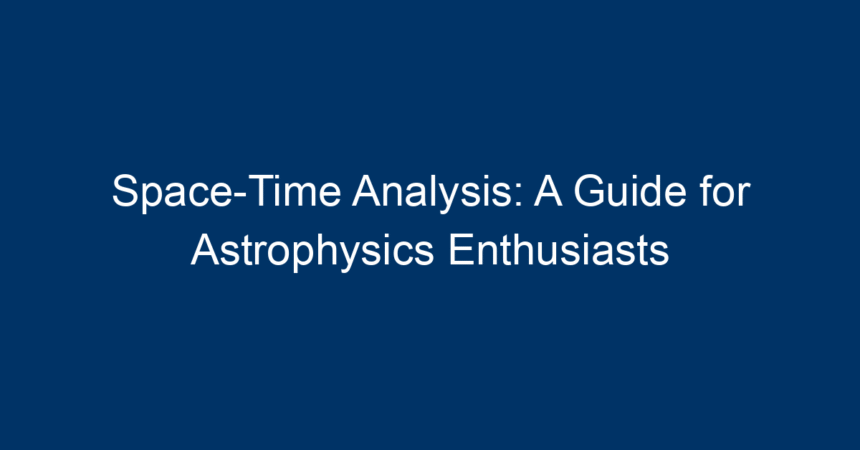Space-time analysis is a fascinating area of study that merges concepts from physics, mathematics, and cosmology, offering a deeper understanding of the universe we inhabit. For astrophysics enthusiasts, delving into the intricacies of space-time can be not just intellectually rewarding but also essential for understanding various celestial phenomena. In this guide, we’ll break down the principles of space-time analysis, explore its implications in astrophysics, and provide actionable insights for further learning.
What is Space-Time?
The Concept of Space-Time
Space-time is a four-dimensional continuum that merges the three dimensions of space with the dimension of time. Albert Einstein introduced this revolutionary idea in his theories of special and general relativity, fundamentally altering our perception of the universe. Instead of viewing time and space as separate entities, space-time analysis invites us to consider how they interact and shape our understanding of events and objects in the universe.
The Significance of Space-Time in Physics
At the core of modern physics, space-time analysis helps explain phenomena such as gravity, the behavior of light, and the structure of the universe itself. It allows physicists to model how objects move through the universe, establishing a framework for understanding gravitational effects, time dilation, and even the expansion of the universe.
Principles of Space-Time Analysis
1. The Geometry of Space-Time
The geometric interpretation of space-time is crucial to understanding its properties. There are two primary geometrical perspectives: Minkowski space, which describes flat, non-curved space-time in special relativity, and curved space-time in general relativity.
-
Minkowski Space: In this model, the positions of objects and events are plotted in a four-dimensional coordinate system, making it easier to visualize relationships between time and space. The key takeaway here is that light travels at a constant speed, and thus, space and time are intertwined.
- Curved Space-Time: General relativity posits that massive objects, such as stars and planets, warp the fabric of space-time. This curvature dictates the motion of other objects, which respond to gravitational forces as they follow "geodesics" or the shortest paths in this curved space.
2. Time Dilation and Length Contraction
Space-time analysis also involves understanding relativistic effects, which become significant at speeds close to the speed of light.
-
Time Dilation: As an object moves faster and approaches the speed of light, time itself appears to slow down for that object from the perspective of a stationary observer. This is a phenomenon that has been experimentally validated through numerous experiments involving high-velocity particles.
- Length Contraction: Conversely, as objects approach the speed of light, their length contracts in the direction of motion. This counterintuitive concept plays a pivotal role in space-time analysis, emphasizing the non-uniformity of space and time as experienced by moving observers.
3. Gravitational Time Dilation
Gravitation affects time itself, a concept encapsulated in the term "gravitational time dilation." According to general relativity, time runs slower in stronger gravitational fields. An example of this can be found near a black hole, where the immense gravitational pull significantly affects the passage of time.
Applications of Space-Time Analysis in Astrophysics
1. Understanding Black Holes
Black holes are one of the most compelling applications of space-time analysis. When massive stars collapse, they warp space-time to such an extent that not even light can escape their gravitational grasp. Studying the surrounding space-time provides valuable insights into black hole formation, behavior, and the effects of extreme gravity.
2. Cosmic Vistas: The Expansion of the Universe
Space-time analysis also sheds light on the expansion of the universe. By studying distant galaxies and cosmic microwave background radiation, astrophysicists can analyze how space-time has evolved since the Big Bang. This analysis is crucial for understanding dark energy, a mysterious force driving the universe’s accelerated expansion.
3. Gravitational Waves
The detection of gravitational waves in 2015 marked a revolution in astrophysics. These ripples in space-time, caused by massive accelerating objects (like spiraling black holes), provide a new way to observe and analyze cosmic events. Space-time analysis is indispensable for interpreting the data from gravitational wave observatories.
Tools and Techniques for Space-Time Analysis
1. Mathematical Modeling
Mathematics is the cornerstone of space-time analysis. Tools such as tensor calculus, differential geometry, and quantum mechanics are frequently employed to model and analyze complex interactions.
-
Tensor Calculus: This mathematical framework helps describe the curvature of space-time, enabling predictions about gravitational interactions.
- Differential Geometry: Essential for understanding the geometric properties of space-time and the shapes formed by massive objects.
2. Computational Simulations
Given the complexities involved in space-time analysis, computational simulations play an integral role. Programs like MATLAB, Python (with libraries like NumPy and SciPy), and specialized astrophysics software allow enthusiasts and professionals to model scenarios in space-time.
3. Observational Tools
Telescopes and satellite data provide invaluable insights into space-time phenomena. Tools like the Hubble Space Telescope and various ground-based observatories collect data that inform our understanding of the universe, serving as a practical application of space-time analysis.
Actionable Insights for Aspiring Astrophysics Enthusiasts
-
Engage with Educational Resources: Start with foundational courses in astrophysics, physics, and mathematics. Websites like Coursera, EdX, and Khan Academy offer excellent resources.
-
Experiment with Software: Familiarize yourself with programming languages like Python. Build simple simulations or work with existing code related to space-time phenomena.
-
Join Online Communities: Engage with forums, social media groups, and online platforms related to astrophysics and space-time analysis. Communities like Reddit’s r/askastronomy or Stack Exchange can be great places for discussion and Q&A.
-
Read Books and Articles: Explore books like "A Brief History of Time" by Stephen Hawking or "The Elegant Universe" by Brian Greene to gain a popular science perspective.
- Attend Workshops and Lectures: Look for webinars, online lectures, or local workshops on astrophysics and space-time analysis. Institutions like Caltech and CERN often host such events.
Conclusion
Space-time analysis is a captivating field that opens up a multitude of avenues for discovery and understanding in astrophysics. By merging the dimensions of space and time, this area of study provides insights that are not only essential for theoretical physics but also for comprehending the universe’s complexities. For aspiring astrophysics enthusiasts, the journey through space-time analysis is filled with learning opportunities, practical applications, and the thrill of exploration. Embrace this fascinating subject, delve deeper into its principles, and who knows? Perhaps you will contribute to unraveling the mysteries of the cosmos!




